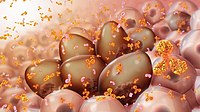
The role of early magnetic resonance imaging in predicting survival on bevacizumab for recurrent glioblastoma: Results from a prospective clinical trial (CABARET)
Sign Up to like & getrecommendations! Published in 2017 at "Cancer"
DOI: 10.1002/cncr.30838
Abstract: BACKGROUND Bevacizumab has been associated with prolonged progression-free survival for patients with recurrent glioblastoma; however, not all derive a benefit. An early indicator of efficacy or futility may allow early discontinuation for nonresponders. This study… read more here.
Keywords: recurrent glioblastoma; magnetic resonance; bevacizumab; resonance imaging ... See more keywords

Nivolumab for patients with recurrent glioblastoma progressing on bevacizumab: a retrospective case series
Sign Up to like & getrecommendations! Published in 2017 at "Journal of Neuro-Oncology"
DOI: 10.1007/s11060-017-2466-0
Abstract: A single institution retrospective evaluation of nivolumab following disease progression on bevacizumab in adults with recurrent glioblastoma (GBM) with an objective of determining progression free survival (PFS). There is no accepted therapy for recurrent GBM… read more here.
Keywords: gbm; nivolumab; recurrent glioblastoma; patients recurrent ... See more keywords

Phase II trial of an AKT inhibitor (perifosine) for recurrent glioblastoma
Sign Up to like & getrecommendations! Published in 2019 at "Journal of Neuro-Oncology"
DOI: 10.1007/s11060-019-03243-7
Abstract: Perifosine (PRF) is an oral alkylphospholipid with antineoplastic effects and reasonable tolerability. It inhibits signaling through the PI3/AKT axis and other cascades of biologic importance in glioblastoma, and has promising pre-clinical activity in vitro and… read more here.
Keywords: akt; phase; trial; glioblastoma ... See more keywords

Congress of Neurological Surgeons systematic review and evidence-based guidelines update on the role of radiation therapy in the management of progressive and recurrent glioblastoma in adults
Sign Up to like & getrecommendations! Published in 2021 at "Journal of Neuro-Oncology"
DOI: 10.1007/s11060-021-03857-w
Abstract: These recommendations apply to adult patients (18 years of age and above) with progressive/recurrent glioblastoma multiforme (pGBM) after first line combined multimodality treatment. Can re-irradiation (by using conventional radiotherapy, fractionated radiosurgery, or single fraction radiosurgery)… read more here.
Keywords: progressive recurrent; recurrent glioblastoma; irradiation; radiation ... See more keywords

Impacts of genotypic variants on survival following reoperation for recurrent glioblastoma
Sign Up to like & getrecommendations! Published in 2022 at "Journal of Neuro-Oncology"
DOI: 10.1007/s11060-021-03917-1
Abstract: Recurrent glioblastoma (rGBM) prognosis is dismal. In the absence of effective adjuvant treatments for rGBM, re-resections remain prominent in our arsenal. This study evaluates the impact of reoperation on post-progression survival (PPS) considering rGBM genetic… read more here.
Keywords: survival; recurrent glioblastoma; rgbms; reoperation ... See more keywords

Cs-131 brachytherapy for patients with recurrent glioblastoma combined with bevacizumab avoids radiation necrosis while maintaining local control.
Sign Up to like & getrecommendations! Published in 2020 at "Brachytherapy"
DOI: 10.1016/j.brachy.2020.06.013
Abstract: PURPOSE Re-irradiation of recurrent glioblastoma (GBM) may delay further recurrence but re-irradiation increases the risk of radionecrosis (RN). Salvage therapy should focus on balancing local control (LC) and toxicity. We report the results of using… read more here.
Keywords: brachytherapy; local control; recurrent glioblastoma; 131 brachytherapy ... See more keywords

Clinical outcomes in recurrent glioblastoma with bevacizumab therapy: An analysis of the literature
Sign Up to like & getrecommendations! Published in 2017 at "Journal of Clinical Neuroscience"
DOI: 10.1016/j.jocn.2017.06.070
Abstract: Bevacizumab (BEV) is a common treatment for recurrent glioblastoma (GBM). After progression on BEV, there is no consensus on subsequent therapy, as multiple chemotherapy trials have failed to demonstrate discernible activity for salvage. A previous… read more here.
Keywords: therapy; bevacizumab; progression bev; bev ... See more keywords

Whole genome and biomarker analysis of patients with recurrent glioblastoma on bevacizumab: A subset analysis of the CABARET trial
Sign Up to like & getrecommendations! Published in 2019 at "Journal of Clinical Neuroscience"
DOI: 10.1016/j.jocn.2019.08.044
Abstract: The CABARET trial (ACTRN12610000915055) reported no difference in overall survival (OS) between patients with recurrent glioblastoma (GBM) randomized to either bevacizumab monotherapy or bevacizumab plus carboplatin. However, a subset of patients showed durable responses and… read more here.
Keywords: bevacizumab; cabaret trial; analysis; biomarker ... See more keywords

Re-irradiation of recurrent glioblastoma using helical TomoTherapy with simultaneous integrated boost: preliminary considerations of treatment efficacy
Sign Up to like & getrecommendations! Published in 2020 at "Scientific Reports"
DOI: 10.1038/s41598-020-75671-9
Abstract: Although there is still no standard treatment for recurrent glioblastoma multiforme (rGBM), re-irradiation could be a therapeutic option. We retrospectively evaluated the efficacy and safety of re-irradiation using helical TomoTherapy (HT) with a simultaneous integrated… read more here.
Keywords: irradiation; treatment; boost; recurrent glioblastoma ... See more keywords

Thrombocytopenia limits the feasibility of salvage lomustine chemotherapy in recurrent glioblastoma: a secondary analysis of EORTC 26101.
Sign Up to like & getrecommendations! Published in 2022 at "European journal of cancer"
DOI: 10.1093/neuonc/noac174.252
Abstract: BACKGROUND Thrombocytopenia represents the main cause of stopping alkylating chemotherapy for toxicity. Here, we explored the incidence, and the consequences for treatment exposure and survival, of thrombocytopenia induced by lomustine in recurrent glioblastoma. METHODS We… read more here.
Keywords: group; thrombocytopenia; recurrent glioblastoma; patients group ... See more keywords

Quantitative imaging biomarkers for risk stratification of patients with recurrent glioblastoma treated with bevacizumab
Sign Up to like & getrecommendations! Published in 2017 at "Neuro-Oncology"
DOI: 10.1093/neuonc/nox092
Abstract: Background Anti-angiogenic therapy with bevacizumab is the most widely used treatment option for recurrent glioblastoma, but therapeutic response varies substantially and effective biomarkers for patient selection are not available. To this end, we determine whether… read more here.
Keywords: stratification; progression; imaging; recurrent glioblastoma ... See more keywords